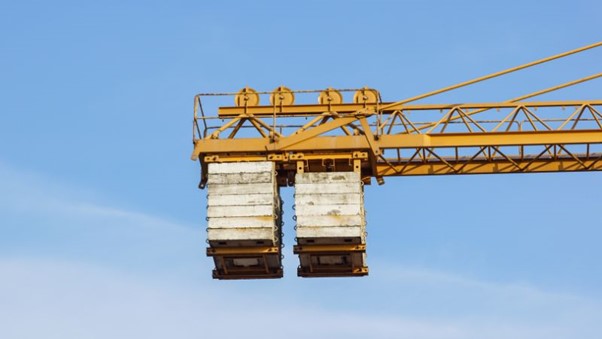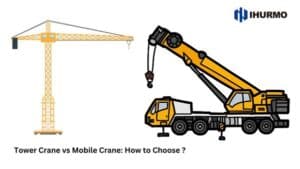Tower cranes are mast equipment used in construction projects to lift and move heavy materials and heavy loads.
However, these machines require careful balancing to prevent tipping over, and that’s where counterweights come into play.

What are Tower Crane Counterweights?
When you look at a tower crane, you’ll notice big weights hanging near the base. These are counterweights, and they play a crucial role in the crane’s performance. Their main job is to balance the crane’s weight with the weight of the load it lifts.
Imagine you’re holding a heavy bag in one hand; you’d lean to the opposite end to keep from falling over. Counterweights work the same way.
This balance is called equilibrium.
Why are Crane Counterweights important?
The tower crane counterweight is essential for:
- Maintaining stability and preventing the crane from tipping.
- Increasing lifting capacity.
- Enhancing safety.
- Maintaining stability in wind.
- Adjusting for different configurations.

Material Selection for Counterweight
Your tower crane’s counterbalance largely depends on the density and weight of the materials used.
Concrete is a popular choice with high density, cost-effectiveness, and versatility, allowing for customized shapes and sizes to provide stability. Additionally, it offers durability and low maintenance, making it suitable for long-term use in various environments.
When considering materials, engineers often opt for those that offer the best balance of weight and volume. Sometimes, lightweight materials are added to the design, especially if the crane needs to be mobile or easily transportable.
Operational Mechanics of Counterweights
Balancing Force and Torque

Both the jib and counter-jib are crucial for managing the load moment—the product of the load’s weight and its distance from the pivot point. The central ballast helps keep the crane anchored at its base, providing additional stability. The jib reaches out to lift the load while the counter-jib extends in the opposite direction, with counterweights to balance the moment created by the load.
For better understanding:
- Force: It’s the push or pull that the crane exerts to lift the load.
- Torque (moment): This results from force applied at a distance from the pivot point, which in a crane’s case, is the load lifted at a specific radius from its base.
For a tower crane, the jib—the part that holds the load—and the counter-jib—which holds the counterweights—work together. They must distribute weight to keep the crane steady.
Adjustments for Load Changes
When you change the weight of the load or its distance from the center, the crane must adjust to keep balance. These adjustments might include moving the counterweight or adding additional weight. Here’s how it might work for different scenarios:
- Lighter loads: Less counterweight may be used.
- Heavier loads: More weight is added to the counter-jib.
- Further distances: Weights may be adjusted outward to increase the balancing torque.
How to Calculate the Correct Counterweight?
Determine the Crane’s Lifting Capacity
The crane’s lifting capacity is the maximum weight it can safely lift at a specific radius. This information is usually found in the manufacturer’s manual.
Identify the Load Being Lifted
Determine the weight of the load you intend to lift. This includes the weight of the object itself, any rigging or lifting attachments, and any additional weight due to environmental factors like wind or snow.
Use the Manufacturer’s Formula or Chart
The crane manufacturer will provide a formula or chart to calculate the required counterweight based on the crane’s lifting capacity, load weight, and configuration. Follow the instructions carefully and ensure you use the correct units of measurement.
Adjust for Safety Factors
It’s recommended to add a safety factor to the calculated counterweight to account for unexpected variations in load weight or wind conditions. A 10% to 20% safety factor is often used.
Formula Used in Calculate Counterweight
P=V×μ×g
The weight (P) of the required counterweight is calculated by multiplying its volume (V) by the density of the material used to make it (μ) and the gravitational constant (g), which is 9.81 m/s².
Counterweights in Different Crane Types
Tower cranes have fixed counterweights integrated into their structure.
In contrast, counterweights in mobile cranes like truck cranes and crawler cranes are often removable for better transportation and site flexibility.
Mobile Cranes and Counterweights
Mobile cranes are versatile machines you’ll often see on construction sites. They are mounted on wheels or tracks, allowing them to move around.
Depending on the job, mobile cranes might use fixed or adjustable counterweights. For tasks in rough or uneven terrain, terrain cranes come in handy with their robust counterweights that ensure stability.
Crawler and Truck Cranes
Crawler cranes are a type of mobile crane, but they move on tracks instead of wheels. This design gives them great stability on your construction site without needing to use outriggers.
Counterweights in these cranes are especially important because they support lifting operations on soft ground.
On the other hand, truck cranes are mobile cranes mounted on a rubber tire truck chassis. They come with counterweights that are often driven to the site separately because of their heavy weight.
Choose IHURMO As Your Partner
At Ihurmo, we possess extensive knowledge and experience in all aspects of counterweight selection, installation, and maintenance.
By partnering with Ihurmo, you gain access to a comprehensive range of services that will help you optimize your crane operations and minimize risks. We are committed to providing you with the knowledge and support you need to ensure the safe and reliable operation of your tower cranes.
Frequently Asked Questions
Has the wrong counterweight ever made an accident?
Yes. In 2008, a 7-ton counterweight fell from a tower crane in New York City, killing a pedestrian below. The investigation revealed that the counterweight was not properly secured, and the crane operator had failed to follow safety procedures.
How can we prevent the safety of the workers working with counterweight?
Counterweights should be inspected regularly for any signs of damage or wear. This includes checking for cracks, dents, corrosion, or loose bolts. Damaged or worn counterweights should be replaced immediately, and they must be securely attached to the crane using the appropriate bolts, nuts, and locking mechanisms.






